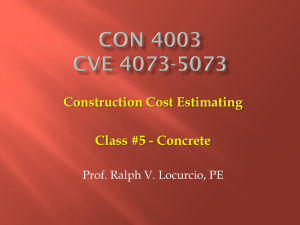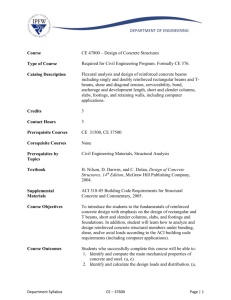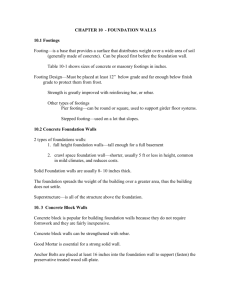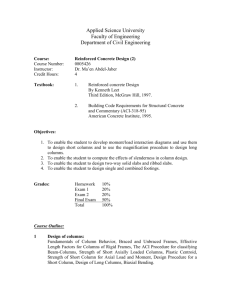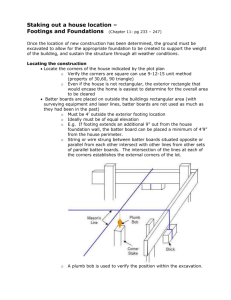INFORMATION BULLETIN ADJUSTABLE STEEL COLUMNS IN RESIDENTIAL OCCUPANCIES
advertisement
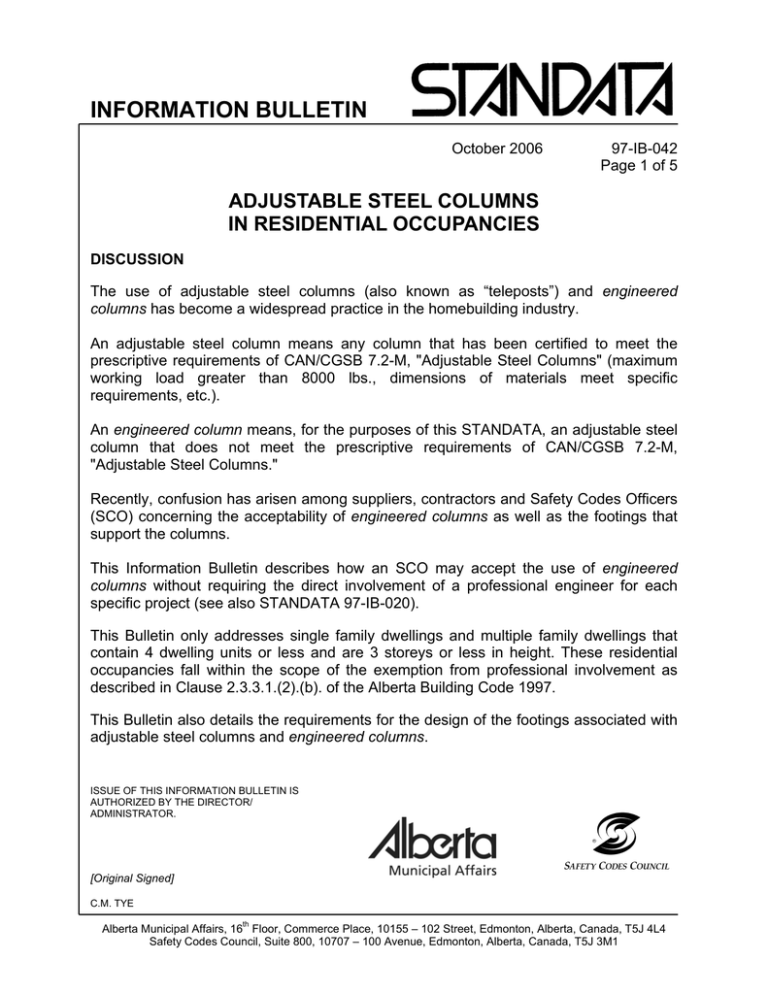
INFORMATION BULLETIN October 2006 97-IB-042 Page 1 of 5 ADJUSTABLE STEEL COLUMNS IN RESIDENTIAL OCCUPANCIES DISCUSSION The use of adjustable steel columns (also known as “teleposts”) and engineered columns has become a widespread practice in the homebuilding industry. An adjustable steel column means any column that has been certified to meet the prescriptive requirements of CAN/CGSB 7.2-M, "Adjustable Steel Columns" (maximum working load greater than 8000 lbs., dimensions of materials meet specific requirements, etc.). An engineered column means, for the purposes of this STANDATA, an adjustable steel column that does not meet the prescriptive requirements of CAN/CGSB 7.2-M, "Adjustable Steel Columns." Recently, confusion has arisen among suppliers, contractors and Safety Codes Officers (SCO) concerning the acceptability of engineered columns as well as the footings that support the columns. This Information Bulletin describes how an SCO may accept the use of engineered columns without requiring the direct involvement of a professional engineer for each specific project (see also STANDATA 97-IB-020). This Bulletin only addresses single family dwellings and multiple family dwellings that contain 4 dwelling units or less and are 3 storeys or less in height. These residential occupancies fall within the scope of the exemption from professional involvement as described in Clause 2.3.3.1.(2).(b). of the Alberta Building Code 1997. This Bulletin also details the requirements for the design of the footings associated with adjustable steel columns and engineered columns. ISSUE OF THIS INFORMATION BULLETIN IS AUTHORIZED BY THE DIRECTOR/ ADMINISTRATOR. [Original Signed] C.M. TYE Alberta Municipal Affairs, 16th Floor, Commerce Place, 10155 – 102 Street, Edmonton, Alberta, Canada, T5J 4L4 Safety Codes Council, Suite 800, 10707 – 100 Avenue, Edmonton, Alberta, Canada, T5J 3M1 This Bulletin is not applicable to other types of columns that may be used in one- and two-family dwellings (i.e. engineered wood, cold-formed structural steel, laminated lumber, etc.). COLUMNS Adjustable steel columns are required by Sentence 9.17.3.4.(1). of the Alberta Building Code 1997 (ABC) to conform to CAN/CGSB 7.2-M, "Adjustable Steel Columns." Columns manufactured to that standard have a maximum allowable working load greater than 36 kN (8000 lbs), and have a minimum and maximum outside diameter of 63 mm (2.50 in.) and 86 mm (3.38 in.), respectively. This is to allow for the installation of the columns in 51x100 mm (2x4) frame-constructed walls. Engineered columns and their associated connections and fittings must be designed according to the provisions of Part 4 of the ABC, which requires professional involvement for the design and conformance to CAN/CSA-S16.1, "Limit States Design of Steel Structures." Traditionally, this would mean professional involvement on a case-by-case basis for each project that includes engineered columns. However, it would be acceptable for manufacturer’s to submit pre-engineered packages of column drawings to the authority having jurisdiction (AHJ) to be retained on file. These packages must be imprinted with the stamp of a professional engineer registered to practice in the province of Alberta. At the time of application for a building permit, the applicant must submit evidence to the AHJ detailing which engineered column will be used (manufacturer, model #, etc.). If the AHJ does not already have the pre-engineered package, the applicant must submit a set of column drawings imprinted with the stamp of a professional engineer registered to practice in the province of Alberta. Additionally, it would be acceptable for contractors to use engineered columns that have been evaluated by the Canadian Construction Materials Centre (CCMC) and are deemed to be acceptable alternatives to the prescriptive requirements in the Code. CCMC evaluations will include the design of the engineered column, including all associated fittings and connections. It is possible that the CCMC evaluation could include the design of the footing as well. Engineered columns that have been evaluated by CCMC and include the design of the footings must be installed exactly according to the terms of the evaluation regarding loads, installation conditions and soil conditions for the footing. 2 / 97-IB-042 FOOTINGS Footings supporting adjustable steel columns or engineered columns can be designed in one of two ways. 1. Unreinforced concrete meeting the requirements of Subsection 9.15.3. 2. Reinforced concrete designed according to Part 4 in compliance with CSA A23.3, "Design of Concrete Structures." Unreinforced Concrete If the column footings are designed using unreinforced concrete, the minimum allowable thickness is 100 mm (4 in.) according to Sentence 9.15.3.6.(1). This thickness may have to be increased to be not less than the projection of the footing beyond the column base plate. Note that there are conditions on the use of unreinforced concrete, as detailed in Article 9.15.3.3. (See CODE REFERENCES at the end of this document.) See also STANDATA 97-DI-010 for more information. Reinforced Concrete If the design of the footings include the use of reinforced concrete or if the design cannot meet the requirements for unreinforced concrete detailed in Article 9.15.3.3., then the design of the footings must conform to Section 4.2. Concrete under Part 4 must be designed by a professional engineer and must conform to the design requirements of CSA A23.3, "Design of Concrete Structures." According to the requirements of CSA A23.1 and A23.3, the minimum thickness of footings for reinforced concrete would be 225 mm, accounting for concrete cover above and below the reinforcement. This minimum thickness may have to be increased due to local soil conditions, applied loads or size of reinforcing. An applicant for a building permit that includes reinforced concrete footings supporting adjustable steel columns or engineered columns must submit evidence to the AHJ that the design of the footings has been performed by a professional engineer registered to practice in the province of Alberta. Evidence must also be supplied to show that the footing design is appropriate for local soil conditions. Pre-engineered footing designs would be considered to be acceptable, provided the designs can be shown to be appropriate for local soil conditions. 3 / 97-IB-042 CODE REFERENCES 2.3.3.1. General … 2) Except as required in Sentence (8), architect and engineer seals and stamps are not required on plans or specifications for the following buildings: … b) a building classified as residential occupancy that, i) is a single family dwelling, or ii) is a multiple family dwelling, that contains 4 dwelling units or less and is 3 storeys or less in height; 4.2.3.5. Concrete 1) Plain, reinforced or prestressed concrete used in foundations or in support of soil or rock shall conform with the requirements of Subsection 4.3.3. 4.3.3.1. Design Basis for Plain, Reinforced and Prestressed Concrete 1) Buildings and their structural members made of plain, reinforced and prestressed concrete shall conform to CSA A23.3, "Design of Concrete Structures." (See Appendix A.) 9.15.3. Footings 9.15.3.1. Footings Required 1) Footings shall be provided under walls, pilasters, columns, piers, fireplaces and chimneys that bear on soil or rock, except that footings may be omitted under piers or monolithic concrete walls if the safe loadbearing capacity of the soil or rock is not exceeded. 9.15.3.2. Support of Footings 1) Footings shall rest on undisturbed soil, rock or compacted granular fill. 9.15.3.3. Footing Sizes 1) Except as provided in Sentences (2) to (8) and in Articles 9.15.3.4. and 9.15.3.5., the minimum footing size shall be as shown in Table 9.15.3.3. provided the span of supported joists does not exceed 4.9 m and the specified live load on any floor supported by the footing does not exceed 2.4 kPa. (See Table 4.1.6.3.) 2) Where the specified live load exceeds 2.4 kPa, footings shall be designed in accordance with Section 4.2. Table 9.15.3.3. Minimum Footing Sizes 3) Except as provided in Sentence (4), where the span of the supported joists exceeds 4.9 m, footings shall be designed in accordance with Section 4.2. 4) Where the supported joist span exceeds 4.9 m, footing sizes are permitted to be determined according to the calculation provided in Appendix A. 5) The strip footing sizes for exterior walls shown in Table 9.15.3.3. shall be increased by 65 mm for each storey of masonry veneer over wood frame construction supported by the foundation wall. 4 / 97-IB-042 6) The strip footing sizes for exterior walls shown in Table 9.15.3.3. shall be increased by 130 mm for each storey of masonry construction supported by the foundation wall. 7) The minimum strip footing sizes for interior walls shown in Table 9.15.3.3. shall be increased by 100 mm for each storey of masonry construction supported by the footing. 8) The footing area for column spacings other than shown in Table 9.15.3.3. shall be adjusted in proportion to the distance between columns. 9.15.3.6. Thickness 1) Footings shall be not less than 100 mm thick except when greater thicknesses are required because of the projection of the footing beyond the supported element. 9.15.3.7. Footing Projection 1) The projection of an unreinforced footing beyond the supported element shall be not greater than the thickness of the footing. 9.17.3.4. Adjustable Steel Columns 1) Adjustable steel columns shall conform to CAN/CGSB 7.2-M, "Adjustable Steel Columns." 5 / 97-IB-042
